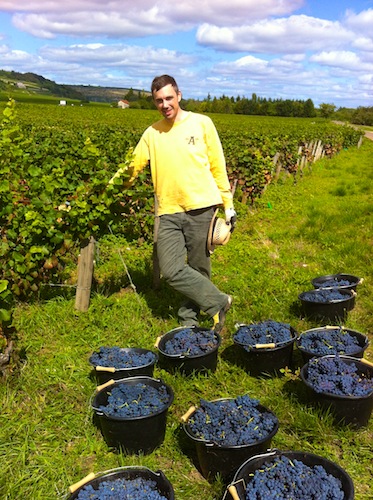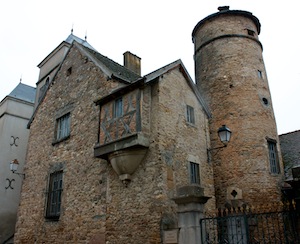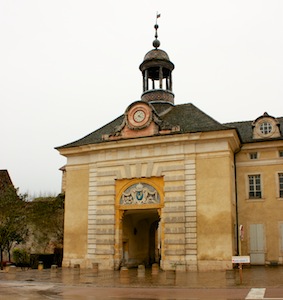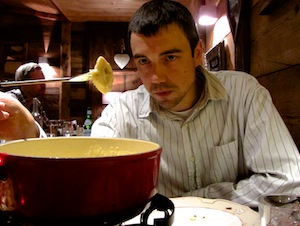My experience with the vendange (or grape harvest) was a little different than Eric’s experience, detailed here. I was out in the field cutting grapes from the vines each day, and, boy, it is hard work to do day after day! The cutting part of the vendange is pretty straightforward: cutting, passing the bucket to be emptied into crates, and cutting some more. Though physically demanding, I found it kind of meditative to be outside and face-to-face with the vines for so long each day.
Most importantly, participating in the vendange really gave me a new appreciation for wine, and something to remember and reflect on whenever I enjoy a glass of wine in the future. My new-found appreciation comes from two somewhat contradictory things I learned about the winemaking process. On one hand, if you know the grapes have been handpicked, you can appreciate the physical effort that goes into the production of wine. On the other hand, once you see how simple it is to do the initial processing, you can understand why this beverage has been around for millennia. So, this is what I will be thinking about in a year or so when I finally get to enjoy the 2015 vintage from Domaine Charton-Vachet.
For those interested in the minutiae of the cutting process, below are the nitty-gritty details:
First, after we congregated at the domaine in the morning, we would head out to the field. The more knowledgeable members of the crew decided how many rows we would pick at a time. Sometimes it was 9 or 10, other times it was only 3 or 4, depending both on how much area was left to pick, how much time we had, and the number of people we had cutting. Usually we went with a one person per row method, but it varied. Then they decided who would be assigned to each row, usually putting the bigger or more experienced people in the rows with crates. This seemed to be because the stronger people could help empty the buckets easier and the more experienced people could both do this and easily keep up with the pace. Then we started cutting! When we would near the end of a section of rows, those who finished first would step over to unfinished rows and help out. It made it seem like a team race where the pace of everyone else pushes you to perform as quickly as possible and your teammates help you over the finish line if needed.
The cutting method is basically to brush/tear away leaves blocking your view, and then cut the grapes off the vine as well and as quickly as you can manage with a pair of small garden clippers. Most of the time the grapes were easy to spot and cut off the vine, but sometimes clumps of grapes were tangled together or in the wires supporting the vines. After cutting away all the obvious clusters of grapes, I would give the plant a good final scan and maybe brush the leaves once more just to check for any hidden clusters before moving on to the next plant. Sometimes clumps of grapes get overlooked, so one way we dealt with this was to scan the rows as we walked back down them after finishing a section. Sometimes whole vines would be missed if two or more people were working the same row and they weren’t conscientious — you really don’t want that to happen, but people weren’t always very predictable in where they started and ended a section of cutting.
The vines themselves were quite variable in terms of the number of grapes they produced. Some had 15 clusters of grapes and others had only one. The size or the quantity of vegetation didn’t always predict how many grapes a vine produced. The Chardonnay plants were quite hardy and easily stood up to tearing away leaves. The Pinot Noir plants seemed more delicate and fragile, but the grapes stood out so well on those vines that you didn’t need to rip away too many leaves. We also picked some Gamay, and those vines were more scraggly than any of the others.

The thing that makes being a cutter hard work is that grapes on typical Burgundian vines are usually about 1 to 1.5 feet off the ground (30 to 45 cm). This requires the cutter to bend over, lunge, kneel down on one or both knees, squat, or sit. None of these positions are very ideal to repeatedly perform at a quick pace over the course of a full day of grape harvesting. Bending over is hard on your back and could contribute to a bit of acid reflux after the morning snack or the 4-course french lunch provided by the domaine. Constantly lunging really works the leg muscles. Kneeling and squatting are hard on the knees, and with kneeling you also have to deal with avoiding all the rocks in the field. Sitting might be seem comfortable, but sitting is also problematic due to mud and prickly plant life growing alongside the grapes. Thus, the reality is that you do some combination of all of these positions over the course of a day.
For me, at the end of the first day my knees hurt a bit and my abs were surprisingly sore. Leg muscle and back pain seemed to only last so long as I was actually cutting in stances requiring use of those body parts. The next morning though, I could barely kneel; my knees were so sore after a night’s rest. This is how it continued for the remaining days. After an hour of cutting each morning, my knees would loosen up a bit so that kneeling and squatting were possible, but they would stiffen up again during the lunch break. Ultimately though I just started to tune the pain out by the end of each day, focusing instead on finishing the next row of vines.
For the uninitiated, four days of vendange is certainly enough to get the complete experience and to come away with a few battle scars. I highly recommend doing it if you have the opportunity, an interest in wine, and you aren’t one to shy away from character-building work.






 Fromage
Fromage